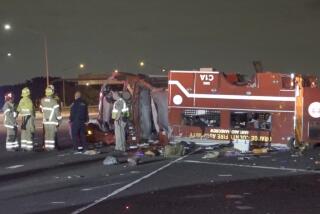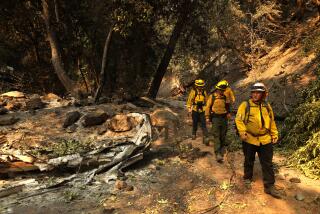Bay Area interchange collapse likely to cause weeks of chaos
- Share via
SAN FRANCISCO — A gasoline tanker truck crashed and exploded into a tower of flames early Sunday, causing a 170-foot stretch of a major Bay Area freeway interchange to warp and collapse on the freeway below, authorities said.
The accident forced the closure of two damaged sections of the heavily traveled maze east of the Bay Bridge, which carries 270,000 vehicles to and from San Francisco each day. Repairs are expected to disrupt traffic for weeks and, some say, months.
“It won’t be a matter of days,” said California Department of Transportation spokesman Bob Haus. “It will be significant.”
No one was killed although the driver of the truck suffered moderate burns.
As demolition of the damaged sections began late Sunday, Gov. Arnold Schwarzenegger issued an emergency declaration to help expedite repairs by streamlining contracting procedures and providing swift funding.
“Undoubtedly,” he said, “today’s incident will cause severe difficulties for Bay Area commuters.”
The incident at the interchange, known locally as the MacArthur Maze, once again demonstrated the vulnerability of California’s crowded freeway systems to serious disruption, whether from accidents or natural disasters such as the 1994 Northridge earthquake and the 1989 Loma Prieta earthquake.
Sunday’s collapse is expected not only to snarl commuter traffic but also the flow of trucks to the busy Port of Oakland, one of the nation’s largest ports along with Los Angeles and Long Beach.
The mayors of San Francisco and Oakland expressed fear that rebuilding could take months -- and they braced for severe vehicle congestion Monday and for the coming weeks.
“This will be one of the most problematic commutes in recent memory,” San Francisco Mayor Gavin Newsom told reporters at the California Democratic Party convention in San Diego.
After the truck with a trailer carrying 8,600 gallons of gasoline overturned, the fuel ignited and witnesses reported seeing flames shoot more than 200 feet in the air, the California Highway Patrol said.
Jennifer L. Summers, 36, a free-lance costume designer, was heading east off the Bay Bridge to her home in the Oakland hills when she spotted thick, black smoke ahead. When she pulled off the road, she saw flames rising from the ground.
“There were explosions happening. And there were huge orange, red and yellow flames,” she said. “You could see that it was actually burning the freeway.”
Meanwhile, Summers saw people driving through the smoke and flames and heard a “creaking sound” as the section of freeway fell.
Although the collapsed section of freeway was left with charred concrete and twisted metal, the CHP said the only reported injury was to the tanker’s driver, who despite his burns flagged down a taxi for a ride to a hospital.
The CHP said the initial investigation revealed that driver James Mosqueda, 51, of Woodland, was traveling at an unsafe speed when his tanker hit a guardrail.
A spokeswoman at St. Francis Memorial Hospital in San Francisco, where Mosqueda was transferred after several hours of treatment at a Kaiser Foundation Hospital in Oakland, said he requested that information on his condition not be released.
The accident occurred about 3:45 a.m. on a roadway that normally thunders with commuters.
“We are fortunate that the incident took place at a time of the morning where there were not a lot of people on the freeway,” said Oakland Mayor Ron Dellums, adding that many people could have been injured or killed if the freeway had been packed with vehicles.
The accident happened near the scenes of two of the Bay Area’s best-known disasters.
In 1982, seven people were killed in the Caldecott Tunnel after a stalled car, a bus and a gasoline tanker were involved in a fiery crash.
During the 1989 Loma Prieta earthquake, 42 motorists were killed when a stretch of Oakland freeway collapsed, and another died when a portion of the Bay Bridge buckled.
Caltrans Director Will Kempton declined to estimate how long it would take to repair Sunday’s freeway damage.
But he said that repairs to the Bay Bridge after Loma Prieta -- which took about 30 days, although the eastern span is now being replaced -- were simpler because they involved elevating a section of deck.
Fixing the East Bay interchanges, Kempton said, will be more like the work that was needed to repair buckled portions of Interstate 10 after the Northridge earthquake. That job took 55 days, but Kempton said the job of fixing I-580 and I-880 in Oakland is somewhat smaller.
“We’re going to move with as much speed as we can because we can recognize the significant traffic impacts,” he said.
Repair work could take “several months, and that’s if we are really fast at doing it,” said Frieder Seible, a bridge-engineering specialist who is dean of the engineering school at UC San Diego. To speed up the work, Seible said, the state need only draw on lessons learned from the Northridge earthquake, when contractors were paid extra to work round-the-clock, and freeways were repaired in record time.
Seible, who chairs the Caltrans seismic advisory board, said no economical way exists to engineer interchanges so that they won’t fail in highly unusual circumstances such as Sunday’s explosion.
“It’s very difficult to design for these extremely rare, extreme conditions, and it would really drive our bridge costs through the roof -- they’re expensive enough, the way it is,” he said.
The CHP said the truck crashed on the interchange from westbound Interstate 80 to southbound Interstate 880, which carries traffic from Berkeley and Vallejo south toward San Jose. The CHP said intense flames and heat from the fire caused the overhead connector from eastbound Interstate 80 to eastbound 580, which carries traffic from San Francisco into the East Bay, to fall onto the interchange.
The CHP initially reported a 250-foot section collapsed. But Kempton said that engineers later found that two 85-foot spans of freeway collapsed, although other sections exposed to fire and heat must be examined to determine whether they suffered structural damage and would need repairs. Repairs, he said, probably would cost tens of millions of dollars.
The upper roadway failed, Kempton said, because high heat warped steel girders, causing them to shear off bolts and slip off their columns.
“It’s like a blacksmith working with metal,” he said.
State officials are concerned not only about commuter traffic in the coming days, but also about disruption of commercial truck traffic, especially to the Port of Oakland.
Dale Bonner, secretary for the state Business, Transportation and Housing Agency, said, “We need to get the work done as soon as possible and get the information out so the truckers in particular can reroute” around the most congested areas.
Economist Brad Williams, a consultant to the Assembly Appropriations Committee, said that the accident could hurt some businesses but that he did not expect a broad effect on the region’s economy.
“It’s at a very bad place, and will create serious bottlenecks, but it’s not the same as having the bridge down [after Loma Prieta],” he said. “There will be alternate routes.”
Officials encouraged motorists to carpool, find routes around the closure and take public transportation, which will be free Monday. The Bay Area Rapid Transit District announced that it would run longer trains Monday and increase its capacity by 50% to help relieve traffic congestion.
In a statement, Newsom said extra police and parking control officers will help commuters get on and off the Bay Bridge as smoothly as possible.
“The accident will cause some inconvenience,” he said. “But I want to make it clear that we will do everything possible we can to ensure that San Francisco’s civic, business and cultural institutions continue to operate without interruption.”
*
The Associated Press contributed to this report.
More to Read
Sign up for Essential California
The most important California stories and recommendations in your inbox every morning.
You may occasionally receive promotional content from the Los Angeles Times.










